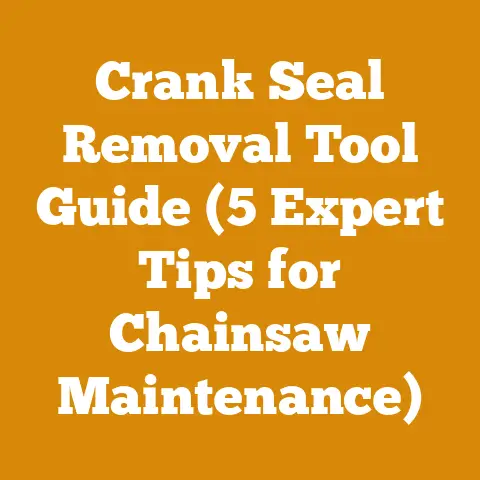Frame for Gazebo: First Timber Build Guide (Step-by-Step Joinery)
Imagine building a house.
You wouldn’t just slap some boards together and hope for the best, right?
You’d need a solid foundation, a well-thought-out frame, and precise joinery to ensure it stands the test of time and weather.
Building a timber-framed gazebo is the same.
It’s about crafting a beautiful and functional outdoor structure that will last for years.
In this guide, I’ll walk you through building a timber frame for a gazebo, focusing on step-by-step joinery techniques.
I’ll share my personal experiences, the technical details you need to know, and the safety precautions that are essential for success.
Frame for Gazebo: First Timber Build Guide (Step-by-Step Joinery)
This guide is designed to help both beginners and experienced woodworkers create a sturdy and attractive timber frame for their gazebo.
I’ll cover everything from selecting the right wood to mastering essential joinery techniques, ensuring your project is both rewarding and structurally sound.
Planning and Design
Before diving into the physical build, meticulous planning is key.
This stage involves designing the gazebo, selecting appropriate materials, and ensuring your design adheres to local building codes.
Gazebo Design Considerations
I always start with understanding the purpose and aesthetic I want to achieve.
Consider these factors:
- Size and Shape: Determine the dimensions based on your available space and intended use.
Common shapes include square, rectangular, hexagonal, and octagonal.
I prefer octagonal gazebos; they offer a more panoramic view and distribute weight evenly. - Style: Match the gazebo’s style to your home and garden.
Options range from rustic to modern, influencing your timber choices and joinery techniques. - Roof Design: The roof significantly impacts the overall look and structural integrity.
Options include hip roofs, gable roofs, and more elaborate designs like a pagoda roof.
A steeper roof pitch (e.g., 45 degrees) will shed snow more effectively, which is crucial in colder climates. - Functionality: Consider if you want built-in seating, a table, or other features.
Plan these elements into your design from the start.
Material Selection: Choosing the Right Timber
Selecting the right timber is crucial for both the gazebo’s appearance and structural integrity.
I’ve learned the hard way that not all wood is created equal.
- Wood Species:
- Hardwoods: Oak, maple, and walnut are durable and visually appealing but can be more challenging to work with due to their density.
Oak, in particular, is excellent for resisting rot and insect infestation, but it requires pre-drilling for nails and screws to prevent splitting. - Softwoods: Pine, cedar, and fir are easier to work with and generally more affordable.
Cedar is naturally resistant to decay, making it an excellent choice for outdoor structures.
Fir is strong but needs to be treated to prevent rot.
- Hardwoods: Oak, maple, and walnut are durable and visually appealing but can be more challenging to work with due to their density.
- Wood Grade: Choose timber with minimal knots and straight grain.
“Select Structural” grade is ideal for load-bearing components. - Moisture Content: Aim for timber with a moisture content between 12% and 18%.
This range minimizes shrinkage and warping after construction.
Use a moisture meter to check the moisture content before you start.
Data Point: A study by the Forest Products Laboratory found that timber with a moisture content above 20% is significantly more susceptible to fungal decay.
Personal Story: I once used timber that I thought was adequately dried, only to find it warped and cracked months after the gazebo was completed.
Now, I always double-check the moisture content and allow the timber to acclimate to the site conditions for at least a week before starting the build.
Measurements and Technical Specifications
Precise measurements are essential for a successful timber frame.
Here’s a breakdown of the key measurements and specifications:
- Post Dimensions: Typically, posts range from 6×6 inches to 8×8 inches, depending on the gazebo’s size.
For a 12-foot square gazebo, I recommend 8×8 posts for added stability. - Beam Dimensions: Beams should be sized appropriately to support the roof load.
A common rule of thumb is to use beams that are at least half the dimension of the posts.
For example, with 8×8 posts, use 4×8 beams. - Rafter Dimensions: Rafters typically range from 2×6 inches to 2×8 inches, depending on the roof span and snow load in your area.
- Joinery Dimensions: Mortise and tenon joints should be sized proportionally to the timber dimensions.
A tenon that is one-third the thickness of the timber is a good starting point.
For example, in an 8×8 post, the tenon should be approximately 2.67 inches thick. - Overall Height: The height of the gazebo should be proportional to its width and length.
A height of 8 to 10 feet is generally comfortable.
Table: Timber Dimensions for a 12-Foot Square Gazebo
Local Building Codes and Regulations
Always check your local building codes before starting construction.
Regulations may dictate specific requirements for:
- Footings: The depth and size of footings are crucial for supporting the gazebo.
Local codes often specify minimum requirements based on soil type and frost depth. - Wind and Snow Load: Ensure your design can withstand the wind and snow loads common in your area.
Consult with a structural engineer if necessary. - Setbacks: Ensure the gazebo is located within the permitted setbacks from property lines.
Essential Tools and Equipment
Having the right tools is crucial for efficient and accurate timber framing.
Here’s a list of essential tools and equipment:
- Chainsaw: A chainsaw is indispensable for cutting large timbers.
I recommend a saw with a bar length of at least 20 inches for handling larger logs.- Technical Requirement: Ensure the chainsaw is properly calibrated and sharpened before each use.
A dull chain can lead to inaccurate cuts and increased risk of kickback.
- Technical Requirement: Ensure the chainsaw is properly calibrated and sharpened before each use.
- Hand Saw: A good hand saw is essential for fine-tuning cuts and creating precise joinery.
A Japanese pull saw is excellent for clean, accurate cuts. - Drill and Impact Driver: A drill is needed for drilling pilot holes and driving screws.
An impact driver is useful for driving large screws into dense timber. - Mortise Chisel: A mortise chisel is specifically designed for creating mortises.
Choose a chisel that is the same width as the tenons you plan to cut. - Mallet: A wooden or rubber mallet is used to drive chisels and assemble joints.
- Measuring Tools: Accurate measuring tools are essential for precise joinery.
This includes a tape measure, a square, a level, and a plumb bob. - Safety Equipment: Always wear appropriate safety gear, including safety glasses, hearing protection, and work gloves.
A hard hat is also recommended when working with heavy timbers. - Lifting Equipment: Depending on the size of your timbers, you may need lifting equipment such as a chain hoist or a come-along.
Data Point: According to OSHA, eye injuries account for a significant percentage of workplace accidents in the construction industry.
Always wear safety glasses when working with wood.
Timber Frame Joinery Techniques
Timber frame joinery is the heart of the construction process.
Mastering these techniques will ensure your gazebo is strong and durable.
Mortise and Tenon Joints
The mortise and tenon joint is the most common type of joint used in timber framing.
It consists of a mortise (a hole) cut into one timber and a tenon (a projection) cut on the end of another timber.
The tenon fits snugly into the mortise, creating a strong and stable connection.
- Layout: Accurately lay out the mortise and tenon locations using a square and a marking gauge.
Precision is key to a tight-fitting joint. - Cutting the Mortise:
- Use a mortise chisel to remove the bulk of the material.
Start by chopping a series of overlapping cuts along the length of the mortise. - Clean up the sides of the mortise with a paring chisel.
Ensure the sides are straight and the corners are square.
- Use a mortise chisel to remove the bulk of the material.
- Cutting the Tenon:
- Use a saw to cut the shoulders of the tenon.
These shoulders should fit tightly against the face of the timber. - Use a saw to cut the cheeks of the tenon.
The tenon should fit snugly into the mortise.
- Use a saw to cut the shoulders of the tenon.
- Assembly:
- Dry-fit the joint to ensure it fits properly.
Make any necessary adjustments before applying glue. - Apply a waterproof glue to the mortise and tenon.
- Drive the tenon into the mortise using a mallet.
- Secure the joint with pegs or screws.
- Dry-fit the joint to ensure it fits properly.
Personal Story: When I first started timber framing, my mortise and tenon joints were often too loose or too tight.
I learned that patience and precision are essential.
Take your time to lay out the joints accurately and make small adjustments as needed.
Dovetail Joints
Dovetail joints are used to connect timbers at right angles.
They are particularly useful for resisting tension and preventing the timbers from pulling apart.
- Layout: Lay out the dovetail shape on both timbers.
The dovetail should be wider at the base than at the top. - Cutting the Dovetail:
- Use a saw to cut the sides of the dovetail.
- Use a chisel to remove the waste material.
- Assembly:
- Dry-fit the joint to ensure it fits properly.
- Apply glue to the joint.
- Slide the dovetail together.
Lap Joints
Lap joints are used to connect timbers end-to-end.
They are simple to make and provide a strong connection.
- Layout: Mark the area to be removed on both timbers.
The depth of the lap should be half the thickness of the timber. - Cutting the Lap:
- Use a saw to cut along the marked lines.
- Use a chisel to remove the waste material.
- Assembly:
- Apply glue to the joint.
- Clamp the timbers together until the glue dries.
- Secure the joint with screws or bolts.
Pegging and Fastening
Pegging and fastening are essential for securing timber frame joints.
- Wooden Pegs: Wooden pegs are traditionally used to secure mortise and tenon joints.
They add strength and prevent the joint from pulling apart.- Technical Requirement: Use pegs made from a durable hardwood such as oak or hickory.
The pegs should be slightly tapered to ensure a tight fit. - Installation: Drill a hole through the mortise and tenon.
Drive the peg into the hole using a mallet.
Trim the excess peg material flush with the surface of the timber.
- Technical Requirement: Use pegs made from a durable hardwood such as oak or hickory.
- Screws and Bolts: Screws and bolts can be used to supplement traditional joinery techniques.
They provide additional strength and can be used in areas where traditional joinery is not practical.- Technical Requirement: Use screws and bolts that are specifically designed for timber framing.
These fasteners are typically longer and stronger than standard screws and bolts. - Installation: Drill pilot holes before driving screws or bolts.
This will prevent the timber from splitting.
- Technical Requirement: Use screws and bolts that are specifically designed for timber framing.
Data Point: A study by Virginia Tech found that pegged mortise and tenon joints are significantly stronger than unpegged joints.
Step-by-Step Construction Process
Now, let’s walk through the step-by-step construction process for building your timber frame gazebo.
Preparing the Footings
The footings are the foundation of your gazebo.
They must be strong and stable to support the weight of the structure.
- Excavation: Excavate holes for the footings according to your local building codes.
The depth and size of the footings will depend on the soil type and frost depth in your area. - Pouring Concrete: Pour concrete into the holes to create the footings.
Ensure the footings are level and plumb. - Anchoring: Embed anchor bolts into the concrete while it is still wet.
These bolts will be used to attach the posts to the footings.
Assembling the Posts and Beams
The posts and beams form the main frame of the gazebo.
- Attaching Posts to Footings: Attach the posts to the footings using the anchor bolts.
Ensure the posts are plumb and level. - Cutting Mortises and Tenons: Cut mortises in the posts to receive the tenons on the beams.
Cut tenons on the ends of the beams. - Assembling the Frame: Assemble the posts and beams using mortise and tenon joints.
Secure the joints with pegs or screws.
Installing the Rafters
The rafters support the roof of the gazebo.
- Cutting Rafters: Cut the rafters to the appropriate length and angle.
- Attaching Rafters to Beams: Attach the rafters to the beams using screws or bolts.
Ensure the rafters are evenly spaced and properly aligned.
Adding Finishing Touches
Once the frame is complete, you can add finishing touches to customize your gazebo.
- Roofing: Install roofing material to protect the gazebo from the elements.
Options include shingles, metal roofing, and wood shakes. - Flooring: Install flooring to create a comfortable and attractive surface.
Options include wood decking, stone pavers, and gravel. - Railings and Trim: Add railings and trim to enhance the appearance of the gazebo.
Example Project: I recently built an octagonal gazebo for a client who wanted a rustic look.
I used rough-sawn oak timbers and traditional mortise and tenon joinery.
The roof was covered with cedar shakes, and the floor was made of reclaimed barn wood.
The result was a beautiful and unique gazebo that perfectly matched the client’s vision.
Technical Detail: For this project, I used a moisture meter to ensure that all the timbers had a moisture content between 12% and 15%.
This helped to minimize shrinkage and warping after construction.
Safety Considerations
Safety should always be your top priority when working with timber and power tools.
- Personal Protective Equipment (PPE): Always wear safety glasses, hearing protection, and work gloves when working with wood.
A hard hat is also recommended when working with heavy timbers. - Tool Safety: Follow the manufacturer’s instructions for operating all power tools.
Ensure that all tools are properly maintained and in good working condition. - Lifting Safety: Use proper lifting techniques to avoid back injuries.
If you are lifting heavy timbers, use lifting equipment such as a chain hoist or a come-along. - Work Area Safety: Keep your work area clean and organized. Remove any tripping hazards.
- Fire Safety: Keep a fire extinguisher nearby when working with power tools.
Sawdust and wood shavings are highly flammable.
Data Point: According to the National Safety Council, falls are a leading cause of injury in the construction industry.
Use ladders and scaffolding safely and always wear fall protection when working at heights.
Maintaining Your Timber Frame Gazebo
Proper maintenance is essential for preserving the beauty and integrity of your timber frame gazebo.
- Regular Inspections: Inspect the gazebo regularly for signs of damage or decay.
Pay particular attention to the joints and connections. - Cleaning: Clean the gazebo regularly to remove dirt and debris.
Use a mild soap and water solution. - Sealing and Staining: Apply a sealant or stain to protect the timber from the elements.
Choose a product that is specifically designed for outdoor use. - Repairing Damage: Repair any damage promptly to prevent it from getting worse.
Replace damaged timbers as needed.
Practical Tip: Apply a water-repellent sealant to the timber every year to protect it from moisture damage.
This will help to extend the life of your gazebo.
Troubleshooting Common Issues
Even with careful planning and execution, you may encounter some challenges during the construction process.
Here are some common issues and how to address them:
- Joints That Are Too Tight: If a joint is too tight, use a chisel or sandpaper to remove material from the tenon or mortise.
- Joints That Are Too Loose: If a joint is too loose, use shims to fill the gap.
You can also try applying a thicker layer of glue. - Timbers That Are Warped or Twisted: If a timber is warped or twisted, use clamps to straighten it.
You may also need to replace the timber if the warp is severe. - Splitting Timber: To prevent splitting timber, pre-drill pilot holes before driving screws or bolts.
You can also use a sharp chisel to make clean cuts.
Case Study: I once had a client who wanted to build a gazebo on a sloped site.
The challenge was to create a level foundation for the gazebo.
I solved the problem by building a series of tiered footings that compensated for the slope.
This allowed me to create a level surface for the gazebo while maintaining its structural integrity.
Technical Detail: For this project, I used a laser level to ensure that the footings were perfectly level.
This was essential for creating a stable foundation for the gazebo.
Conclusion
Building a timber frame gazebo is a challenging but rewarding project.
By following the steps outlined in this guide and paying attention to detail, you can create a beautiful and durable outdoor structure that will last for years to come.
Remember to prioritize safety, use high-quality materials, and take your time to master the essential joinery techniques.
With a little patience and perseverance, you can build a gazebo that you will be proud of for many years.
I hope this guide has provided you with the knowledge and inspiration you need to embark on your own timber frame gazebo project.
Happy building!






